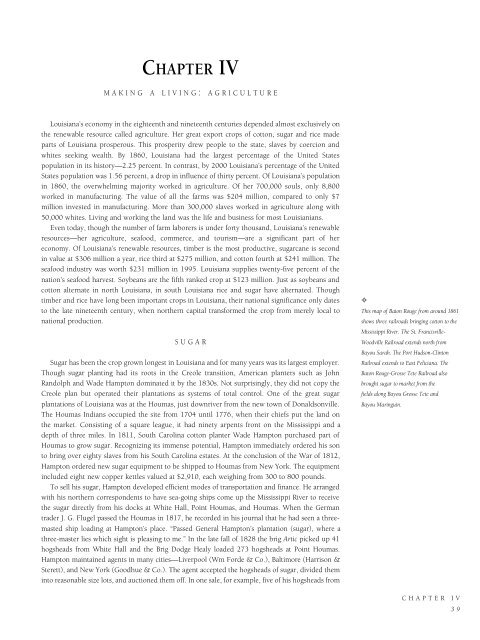Historic Louisiana
An illustrated history of Louisiana, paired with the histories of companies, families and organizations that make the state great.
An illustrated history of Louisiana, paired with the histories of companies, families and organizations that make the state great.
You also want an ePaper? Increase the reach of your titles
YUMPU automatically turns print PDFs into web optimized ePapers that Google loves.
CHAPTER IV<br />
MAKING A LIVING: AGRICULTURE<br />
<strong>Louisiana</strong>’s economy in the eighteenth and nineteenth centuries depended almost exclusively on<br />
the renewable resource called agriculture. Her great export crops of cotton, sugar and rice made<br />
parts of <strong>Louisiana</strong> prosperous. This prosperity drew people to the state, slaves by coercion and<br />
whites seeking wealth. By 1860, <strong>Louisiana</strong> had the largest percentage of the United States<br />
population in its history—2.25 percent. In contrast, by 2000 <strong>Louisiana</strong>’s percentage of the United<br />
States population was 1.56 percent, a drop in influence of thirty percent. Of <strong>Louisiana</strong>’s population<br />
in 1860, the overwhelming majority worked in agriculture. Of her 700,000 souls, only 8,800<br />
worked in manufacturing. The value of all the farms was $204 million, compared to only $7<br />
million invested in manufacturing. More than 300,000 slaves worked in agriculture along with<br />
50,000 whites. Living and working the land was the life and business for most Louisianians.<br />
Even today, though the number of farm laborers is under forty thousand, <strong>Louisiana</strong>’s renewable<br />
resources—her agriculture, seafood, commerce, and tourism—are a significant part of her<br />
economy. Of <strong>Louisiana</strong>’s renewable resources, timber is the most productive, sugarcane is second<br />
in value at $306 million a year, rice third at $275 million, and cotton fourth at $241 million. The<br />
seafood industry was worth $231 million in 1995. <strong>Louisiana</strong> supplies twenty-five percent of the<br />
nation’s seafood harvest. Soybeans are the fifth ranked crop at $123 million. Just as soybeans and<br />
cotton alternate in north <strong>Louisiana</strong>, in south <strong>Louisiana</strong> rice and sugar have alternated. Though<br />
timber and rice have long been important crops in <strong>Louisiana</strong>, their national significance only dates<br />
to the late nineteenth century, when northern capital transformed the crop from merely local to<br />
national production.<br />
SUGAR<br />
Sugar has been the crop grown longest in <strong>Louisiana</strong> and for many years was its largest employer.<br />
Though sugar planting had its roots in the Creole transition, American planters such as John<br />
Randolph and Wade Hampton dominated it by the 1830s. Not surprisingly, they did not copy the<br />
Creole plan but operated their plantations as systems of total control. One of the great sugar<br />
plantations of <strong>Louisiana</strong> was at the Houmas, just downriver from the new town of Donaldsonville.<br />
The Houmas Indians occupied the site from 1704 until 1776, when their chiefs put the land on<br />
the market. Consisting of a square league, it had ninety arpents front on the Mississippi and a<br />
depth of three miles. In 1811, South Carolina cotton planter Wade Hampton purchased part of<br />
Houmas to grow sugar. Recognizing its immense potential, Hampton immediately ordered his son<br />
to bring over eighty slaves from his South Carolina estates. At the conclusion of the War of 1812,<br />
Hampton ordered new sugar equipment to be shipped to Houmas from New York. The equipment<br />
included eight new copper kettles valued at $2,910, each weighing from 300 to 800 pounds.<br />
To sell his sugar, Hampton developed efficient modes of transportation and finance. He arranged<br />
with his northern correspondents to have sea-going ships come up the Mississippi River to receive<br />
the sugar directly from his docks at White Hall, Point Houmas, and Houmas. When the German<br />
trader J. G. Flugel passed the Houmas in 1817, he recorded in his journal that he had seen a threemasted<br />
ship loading at Hampton’s place. “Passed General Hampton’s plantation (sugar), where a<br />
three-master lies which sight is pleasing to me.” In the late fall of 1828 the brig Artic picked up 41<br />
hogsheads from White Hall and the Brig Dodge Healy loaded 273 hogsheads at Point Houmas.<br />
Hampton maintained agents in many cities—Liverpool (Wm Forde & Co.), Baltimore (Harrison &<br />
Sterett), and New York (Goodhue & Co.). The agent accepted the hogsheads of sugar, divided them<br />
into reasonable size lots, and auctioned them off. In one sale, for example, five of his hogsheads from<br />
✧<br />
This map of Baton Rouge from around 1861<br />
shows three railroads bringing cotton to the<br />
Mississippi River. The St. Francisville-<br />
Woodville Railroad extends north from<br />
Bayou Sarah. The Port Hudson-Clinton<br />
Railroad extends to East Feliciana. The<br />
Baton Rouge-Grosse Tete Railroad also<br />
brought sugar to market from the<br />
fields along Bayou Grosse Tete and<br />
Bayou Maringuin.<br />
CHAPTER IV<br />
39
















